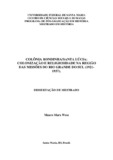| dc.creator | Wesz, Mauro Marx | |
| dc.date.accessioned | 2016-10-04 | |
| dc.date.available | 2016-10-04 | |
| dc.date.issued | 2016-05-31 | |
| dc.identifier.citation | WESZ, Mauro Marx. COLÔNIA RONDINHA/SANTA LUCIA: COLONIZATION AND RELIGIOSITY IN THE REGION OF MISSOES, RIO GRANDE DO SUL, BRAZIL (1919-1937).. 2016. 139 f. Dissertação (Mestrado em História) - Universidade Federal de Santa Maria, Santa Maria, 2016. | por |
| dc.identifier.uri | http://repositorio.ufsm.br/handle/1/9675 | |
| dc.description.abstract | This research seeks to explain issues related to the settlement and historical representations undertaken by the community of Rondinha/Santa Lúcia/Caibaté, in the Missões of Rio Grande do Sul, southern region of Brazil, in the early years of the twentieth century. We take as axis of analysis the territorial appropriation of this location to a better understanding of the process of integration between individuals of different origins that occurred in the rural community of Rondinha/Santa Lúcia. Its settlement occurred from settlers and shifting cultivators, in this case, descendants of european immigrants who were seeking new properties for economic growing, and a group of other persons who were already living there, and were linked to agricultural activities and usually linked to ranchers historically present in that space. The foundation of the Santa Lucia village and the construction of the Sanctuary of Caaro present themselves as intrinsic aspects to understand the firsts activities while community of that society, and the notion of past benchmarks that should be followed. Also we propose to understand how this concept of missioneirism continues to be made among the Pilgrimage‟s of Caaró of penitential character, as well the production of their narratives, for this it‟s essential to relate every aspect mentioned above. That way we can explain a little more about the peculiarities of this place, and who were the agents involved in the tangle of existing social relations in this mixed colony in the early decades of the twentieth century. | eng |
| dc.description.sponsorship | Coordenação de Aperfeiçoamento de Pessoal de Nível Superior | |
| dc.format | application/pdf | por |
| dc.language | por | por |
| dc.publisher | Universidade Federal de Santa Maria | por |
| dc.rights | Acesso Aberto | por |
| dc.subject | Povoamento | por |
| dc.subject | Missioneirismo | por |
| dc.subject | Missões jesuítico-guaranis | por |
| dc.subject | Settlement | eng |
| dc.subject | Missioneirism | eng |
| dc.subject | Jesuit guarani missions | eng |
| dc.title | Colônia Rondinha/Santa Lúcia: colonização e religiosidade na região das Missões do Rio Grande do Sul (1921-1937). | por |
| dc.title.alternative | Colônia Rondinha/Santa Lúcia: colonization and religiosity in the region of Missões, Rio Grande do Sul, Brazil (1919-1937). | eng |
| dc.type | Dissertação | por |
| dc.description.resumo | Esta pesquisa procura explicar questões relacionadas ao povoamento e as representações históricas assumidas pela comunidade de Rondinha/Santa Lúcia/Caibaté na região das Missões, noroeste do Rio Grande do Sul, ao longo das primeiras décadas do século XX. Tomamos por eixo de análise as formas de apropriação territorial neste local para melhor compreender o processo de integração entre indivíduos de diferentes origens que formou a comunidade rural de Rondinha/Santa Lúcia. Seu povoamento ocorreu a partir de colonos e caboclos, neste caso, descendentes de imigrantes europeus que buscavam novas propriedades para o cultivo, e indivíduos que já se encontravam no local, em menor número e ligados às atividades agropecuárias de estancieiros historicamente presentes naquele espaço. A fundação da vila Santa Lúcia e a construção do Santuário do Caaró apresentam-se como aspectos intrínsecos para a compreensão das primeiras atividades enquanto coletividade daquela sociedade e também a noção dos referenciais de passado que deveriam ser seguidos. Para isso utilizamos o conceito de missioneirismo, que continua a ser formulado em meio a Romaria do Caaró, de caráter penitencial, bem como a produção de suas narrativas. Dessa forma poderemos explicar um pouco mais sobre as peculiaridades deste local, e quem eram os agentes envolvidos neste emaranhado de relações sociais existentes nesta colônia mista nas primeiras décadas do século XX. | por |
| dc.contributor.advisor1 | Santos, Julio Ricardo Quevedo dos | |
| dc.contributor.advisor1Lattes | SANTOS, J. R. Q. | por |
| dc.contributor.referee1 | Martins, Maria Cristina Bohn | |
| dc.contributor.referee1Lattes | http://lattes.cnpq.br/5651326902924392 | por |
| dc.contributor.referee2 | Pommer, Roselene Moreira Gomes | |
| dc.contributor.referee2Lattes | http://lattes.cnpq.br/1635475892372110 | por |
| dc.contributor.referee3 | Farinatti, Luís Augusto Ebling | |
| dc.contributor.referee3Lattes | http://lattes.cnpq.br/1043707938149901 | por |
| dc.creator.Lattes | http://lattes.cnpq.br/7136136061512275 | por |
| dc.publisher.country | BR | por |
| dc.publisher.department | História | por |
| dc.publisher.initials | UFSM | por |
| dc.publisher.program | Programa de Pós-Graduação em História | por |
| dc.subject.cnpq | CNPQ::CIENCIAS HUMANAS::HISTORIA | por |


